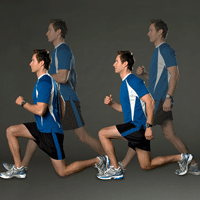Training Methods
Form: It doesn't matter whether someone is swinging his or her shoulders or walking straight from the hip, as long as they're comfortable and have the right intensity. Hoffmann, however, says it's best to have elbows bent at a 90 degree angle, the arms swinging freely so that they come up to about chest level, the fingers curled into a loose fist, and the feet moving forward at a brisk pace. "If your hands are just dangling at the sides, you're probably not walking fast enough to get any heart rate increase," says Hoffmann, who notes that the extremely sedentary and overweight can begin an exercise plan with a stroll and work up to a quicker
pace.
 Mileage: Many guidelines give recommendations on time and intensity, so distance may not necessarily be a factor. On the other hand, some walking events and campaigns with specific distance requirements have been known to be very motivating. For example, Corbin says children have loved digital pedometer programs, which have enabled them to keep track of steps during the day. Students who take a certain number of steps a day for at least five days a week for several weeks receive a President's Council Activity Award. Volkssporting groups have also given honors to walkers of all ages that have achieved particular distances.
Mileage: Many guidelines give recommendations on time and intensity, so distance may not necessarily be a factor. On the other hand, some walking events and campaigns with specific distance requirements have been known to be very motivating. For example, Corbin says children have loved digital pedometer programs, which have enabled them to keep track of steps during the day. Students who take a certain number of steps a day for at least five days a week for several weeks receive a President's Council Activity Award. Volkssporting groups have also given honors to walkers of all ages that have achieved particular distances.
Walking training schedules:
It is important to begin each walk at an easy comfortable pace and only increase effort once the body and muscles have warmed-up. Difficult terrain or travelling uphill and downhill also affects your overall speed.
Beginners' training schedule:It is really beneficial to incorporate other exercises and activities into your training, choose from below a training schedule to suit your ability. And don't forget to check you have the equipment and kit you need for your challenge.



 Mileage: Many guidelines give recommendations on time and intensity, so distance may not necessarily be a factor. On the other hand, some walking events and campaigns with specific distance requirements have been known to be very motivating. For example, Corbin says children have loved digital pedometer programs, which have enabled them to keep track of steps during the day. Students who take a certain number of steps a day for at least five days a week for several weeks receive a President's Council Activity Award. Volkssporting groups have also given honors to walkers of all ages that have achieved particular distances.
Mileage: Many guidelines give recommendations on time and intensity, so distance may not necessarily be a factor. On the other hand, some walking events and campaigns with specific distance requirements have been known to be very motivating. For example, Corbin says children have loved digital pedometer programs, which have enabled them to keep track of steps during the day. Students who take a certain number of steps a day for at least five days a week for several weeks receive a President's Council Activity Award. Volkssporting groups have also given honors to walkers of all ages that have achieved particular distances.